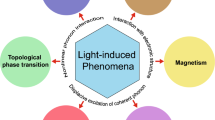Conclusions
-
1.
As the result of these measurements, it was shown that nitrobenzene can provide light modulation at 1010cps.
-
2.
The value of the relaxation time of the nitrobenzene molecules is comparable to that obtained by means of dispersion of electromagnetic waves at the same frequency.
-
3.
A greater depth of modulation can be obtained by a better choice of the dimensions and design of the cell, by raising the power of the UHF generator and by cooling the cell during operation.
-
4.
This method of determining the relaxation time of nitrobenzene can also be used for determining the relaxation time of other substances.
Similar content being viewed by others
Literature cited
I. L. Fabelinskii, Izvest. AN SSSR, Ser. Fiz., 9 (1945).
W. Hanle and O. Z. Märks Phys., 114 (1939).
Transmission Lines for Centimeter Waves [in Russian] (Izd. Sovetskoe Radio, Moscow, 1951).
Rights and permissions
About this article
Cite this article
Simkin, G.S., Naberezhnykh, V.P. & Lukin, I.V. Modulation of light by means of an ultrahigh frequency (1010cps). Meas Tech 3, 694–697 (1960). https://doi.org/10.1007/BF00975741
Issue Date:
DOI: https://doi.org/10.1007/BF00975741




